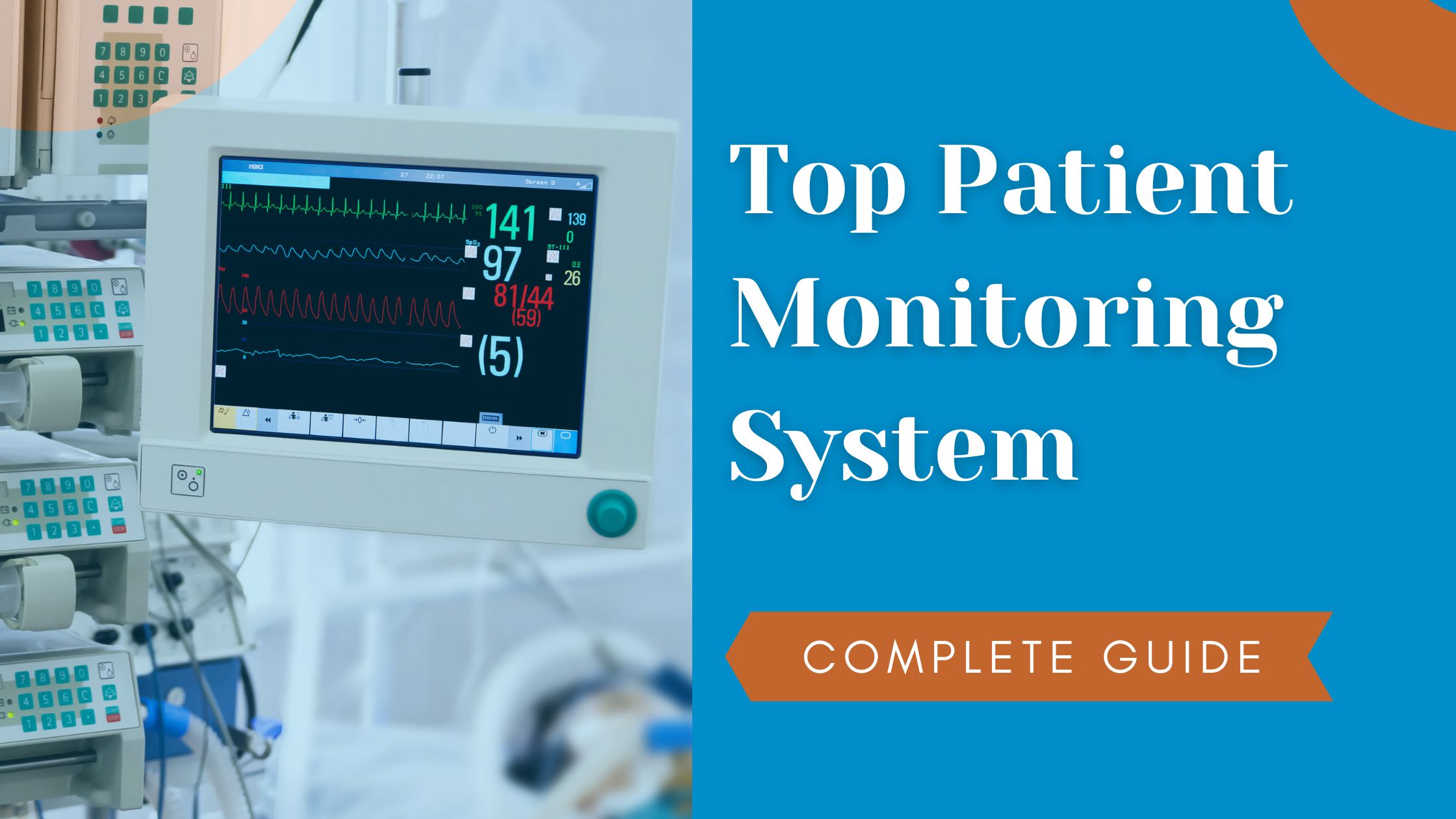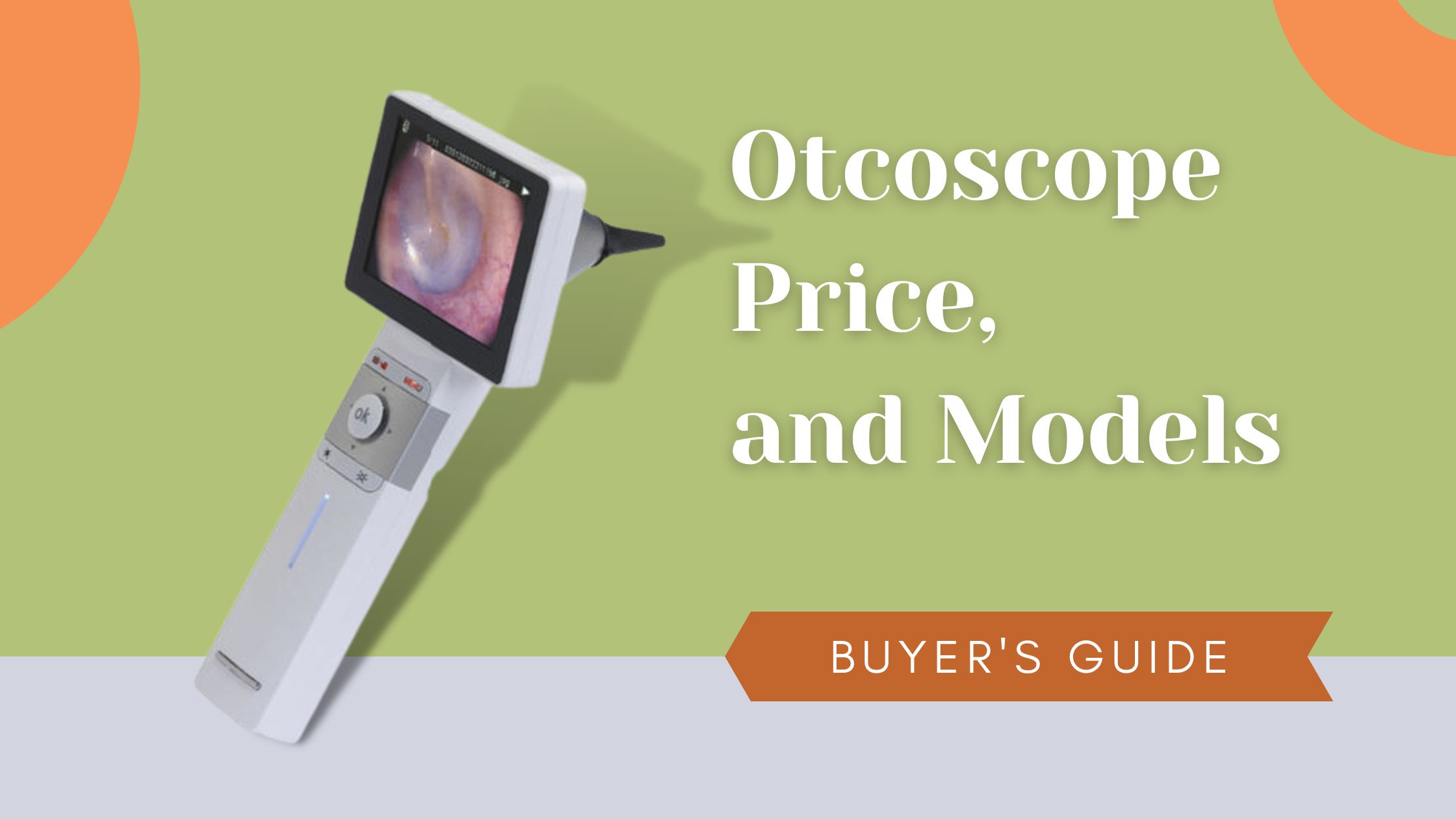A fetal doppler
A Fetal Doppler is a test that uses sound waves able to check the baby’s heartbeat. This is a type of pregnancy doppler ultrasound that uses a handheld device to observe the changes in movements that are translated into sound waves.
Early Stages to check fetal doppler test works?
Most pregnant ladies can hear their baby’s heartbeat during the normal routine checkup by using the fetal doppler. Also, many ultrasound machines allow hearing the heartbeat of the baby’s before hearing that is used with the fetal doppler. Most of the women get the ultrasound before the 12 weeks.
A fetal doppler test usually takes during the second trimester ( from 13 to 28 weeks of the pregnancy) and some manufacturers dopplers machines say you can hear at home a baby’s heartbeat as soon as 8 to 12 weeks of pregnancy. But the expert’s sonographers say; the right time to hear the baby’s heartbeat is after 13 weeks. The reason behind this is that the womb is in your pelvis at the time of the first trimester. That’s why the device didn’t work correctly.
Some at-home usable devices are not to be used before the 16 weeks.
If you want to try to hear your baby’s heartbeat. It is good to be concerned with your doctor first and take first your prenatal checkups. If you are pregnant less than 12 weeks and planning to buy home fetal doppler to avoid unnecessary concern. Talk about the device and know all the benefits and risks involved in this device before moving forward with it.
Fetal doppler test at the clinic
Go to the clinic, you will lie down and the physician will hold the small probe against your abdomen that makes the sound waves. The sound is sent back to an amplifier, where you can hear that the procedure will be safe and painless.
Fetal doppler test at-home
Using a fetal doppler device without an expert guide not to be safe for the mother. Before, using a fetal doppler at home you should check all the instructions and must watch the tutorials videos available with all the instructions. Doing at home is not as smooth as doing it by a physician at the clinic.
Fetal monitoring
In pregnancy and during labor, your doctor asked to check the health of your unborn baby (fetus). This can be done by checking the baby’s heartbeat and other functions.
Fetal monitoring is a general procedure.
Monitoring can be done in two ways;
It can be done internally directly on the baby inside your uterus ( internal monitoring) and it can be done externally outside of your abdomen ( external monitoring).
Difference between external and internal monitoring
External monitoring
This monitoring is done by a special tool called a fetoscope, which is a stethoscope that has a different shape and can also be done by using Doppler. This is an electronic device that uses sound waves and a computer.
Internal monitoring
A small wire electrode is put on your baby’s head when your baby is inside your uterus.
Fetal heart rate monitoring is used to check the rate and rhythm of the heartbeat. It checks how much a baby’s heartbeat increases or decreases. The medium fetal monitoring heart rate should be 110 and 160 beats per minute. The fetus heart rate can be changed and the baby responds to conditions in the uterus. An abnormal fetus shows the baby is not getting enough oxygen and has problems in other functions. An abnormal pattern means emergency cesarean section ( C – section) delivery is needed.
Why? I need fetal monitoring
Using a handheld device and doing fetal monitoring is a common basic type of monitoring, this can be often done during prenatal checkups. Fetal monitoring helps the problems in the baby during the time of late pregnancy and labor. If it can show the other testing or C-section delivery is needed.
- Fetal doppler test at the clinic
- Fetal doppler test at-home
- Fetal monitoring
- Difference between external and internal monitoring
- Why? I need fetal monitoring
- 10 Best Fetal Doppler/Monitor models in India 2021: Detailed
- Demo video of Philips Avalon FM30 Fetal Monitor
- Demo video of Philips Avalon FM20 Fetal Monitoring CTG Machine
- Demo video of BPL Fetal Monitor FM9852, Fetal Heart rate monitoring for Hospitals Baby Monitor
- Demo video of CONTEC Cardiotocography Machine, CMS800G Fetal Monitor baby Heart FHR TOCO Fetal monitoring
- Demo video of Contec Fetal Monitor CMS800G1
- Demo video of Sonicaid Digital SR2/SR3, Digital Doppler with Fetal Heart Rate and Tracings Display
- Demo video of BPL fetal monitor, BPL FM 9853 Fetal Monitor
- Demo video of Sonicaid Team3 Series, Fetal/Maternal Monitor
- Demo video of BD4000AXS-2 Antepartam Fetal Monitor by Arjo Huntleigh
- Demo video of Bistos BT350 Fetal Monitor
- Things to consider before buying fetal doppler
- Price list of fetal dopplers/monitors
- Final thoughts
- Frequently Asked Questions:
10 Best Fetal Doppler/Monitor models in India 2021: Detailed
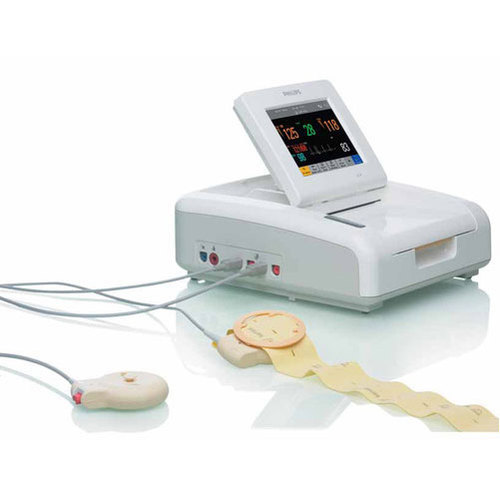
1) Philips fetal monitor, Philips Avalon FM30 Fetal Monitor
- Monitor screen display: 6.5 in/16.51 cm
- Touchscreen operation: Standard
- External fetal parameters: US/Toco
- Twin capability: Standard
- Triplets capability: Optional
- Internal fetal parameters: DECG, IUP
- Smart Pulse technology: Standard
- Cross channel verification Standard
- Fetal movement profil Standard
- NST timer: Standard
- NST trace interpretation (optional): Up to three Fetal Heart Rates (FHR)
- Operating time (optional): Up to four hr
- Weight without battery option: 11.2 pounds/5.1 kg
- Weight with battery option: 11.7 pounds/5.3 kg
- Care stage: Intrapartum
- Patient type: Fetal and maternal
- Not for diagnostic use: DECG, MECG
- PS/2 interfaces: Optional
- System interface (optional): Serial, LAN
- Data buffer: Up to one hour
The Philips Avalon device FM fetal and maternal monitors are Philips’ first and only to offer automated coincidence detection (cross-channel verification) using Smart Pulse, measuring fetal & maternal heart rates separately to enhance diagnostic confidence.
Demo video of Philips Avalon FM30 Fetal Monitor
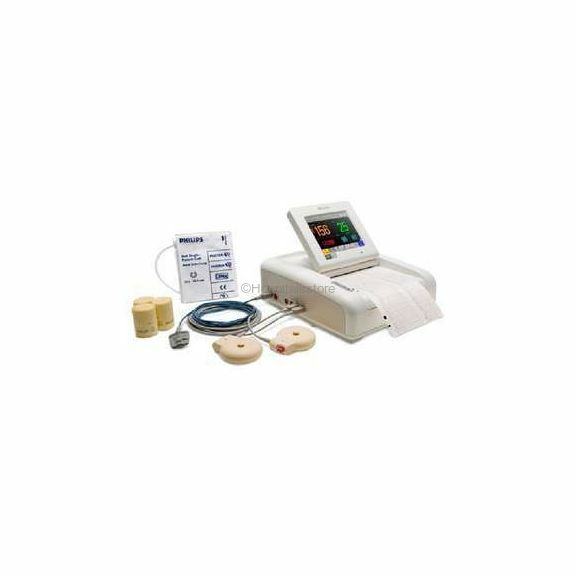
2) Philips Avalon FM20 Fetal Monitoring CTG Machine
- 6.5inch display
- Up To Triplets Monitoring
- Inbuilt Recorder And Printer
- Remote Event Marker
- Advacned Antepartum Fetal Monitor system
- Compact versatile Fetal & Maternal monitoring
- Large touch screen with intutive user interface
- Maternal pulse oxymatry
- With capability for 4 fetal transducers connectors
- Large numeric display
- Built in thermal paper recorder with 6″ paper strips
The Philips CTG, Avalon FM fetal and maternal monitors are Philips first and only to offer automated coincidence detection (cross-channel verification) using Smart Pulse. It measures the fetal & maternal heart rates separately to enhance diagnostic confidence.
Demo video of Philips Avalon FM20 Fetal Monitoring CTG Machine
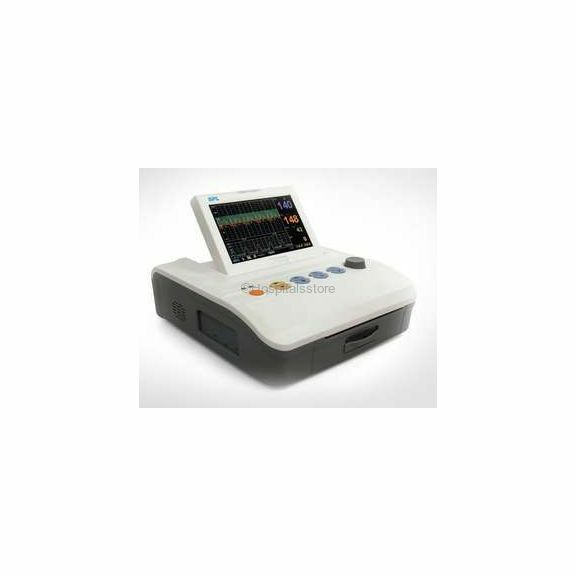
3) BPL Fetal Monitor FM9852, Fetal Heart rate monitoring for Hospitals Baby Monitor
- 7-inch High resolution color LCD with foldable screen
- Monitoring of FHR/Twin FHR (FM 9852T), TOCO, Fetal Movement
- High-sensitivity water-proof ultrasound probe
- Automatic Fetal Movement detection with Event Marker
- Data storage facility, Li-ion Battery, 152mm Thermal printer
The BPL fetal monitor has a main fetal unit, FHR ( Fetal Heart Rate) probe, UC (urinary contraction ) probe, Event marker and paper.
Demo video of BPL Fetal Monitor FM9852, Fetal Heart rate monitoring for Hospitals Baby Monitor
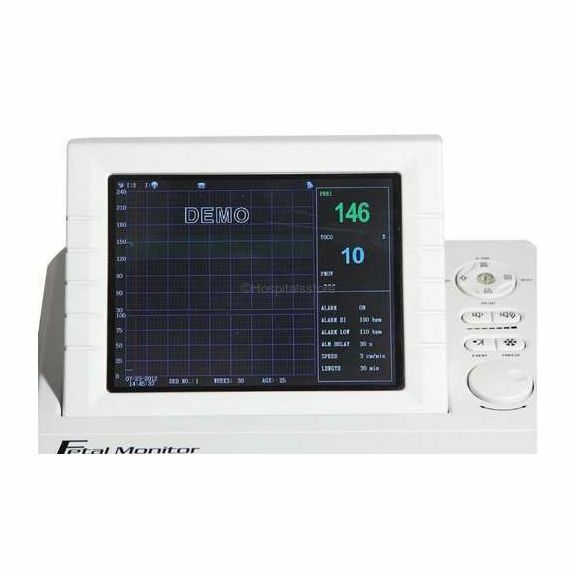
4) CONTEC Cardiotocography Machine, CMS800G Fetal Monitor baby Heart FHR TOCO Fetal monitoring
- Light dexterous appearance, tops horizontally and walls can be hoisted
- 8.0 “screen colour LCD, rotatable screen to 60°
- Display of the patient data and curve clearly
- FHR 120 BPM~160 BPM normal range label
- Manual records fetal movement
- Sound and colour alarm for high and low fetal heart rate
- Continuous 24-hour real-time monitoring function
- Continuous 12-hour patient curve and data storage, playback and print
- With picture freeze function
- Optional English interface
- Single, Twins Monitoring optional
- 9 crystal board band pulsed-wave transducer
- Extra-long life, high-resolution built-in thermal recorder
- A built-in communication port can be connected with the central monitoring system.
Fetal Monitor can acquire fetal heart rate, maternal uterine contraction when pregnancies over 28 weeks to provide reference data for clinical use.The monitor can be used individually or connected with PC through RJ45 Interface for the purpose of central monitoring.
It is only suitable for the equipment in hospitals, clinics, doctors offices and patients at home by professional medical personnel.
Demo video of CONTEC Cardiotocography Machine, CMS800G Fetal Monitor baby Heart FHR TOCO Fetal monitoring
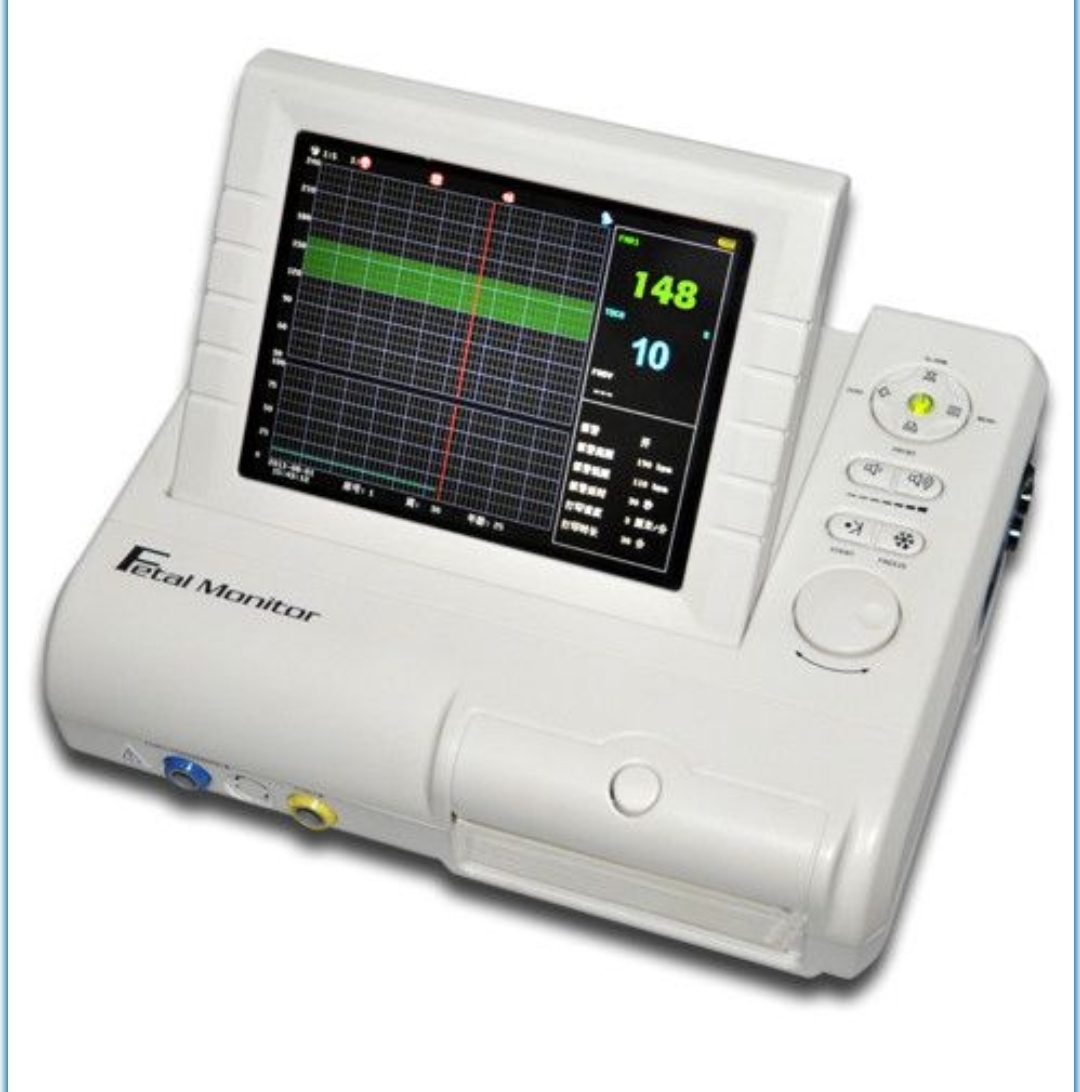
5) fetal monitoring Contec Fetal Monitor CMS800G1
- Compact design, can be placed horizontally or hung on the wall.
- Color LCD, 60° convertible screen
- Area mark for normal FHR(120 BPM~160 BPM).
- Manual record for fetal movement.
- Alarm for abnormal FHR
- Storage, playback and print the monitoring curve for continuous 12 hours.
- Display monitoring curve and data clearly
- Real-time monitoring for a continuous 24 hours.
- Optional interface languages: Chinese and English.
- Optional twins monitoring.
- 9-crystal and broad beam transducer.
- Extra long-life and high-resolution built-in thermal printer.
- Communicate with te central monitoring system by the built-in RJ45.
Fetal Monitor CMS800G1 can acquire FHR, TOCO, and FMOV, real-time which can provide reference data for clinical use. It can be used individually or connected with a central monitoring system in the obstetrical department to form a network monitoring system.
Demo video of Contec Fetal Monitor CMS800G1
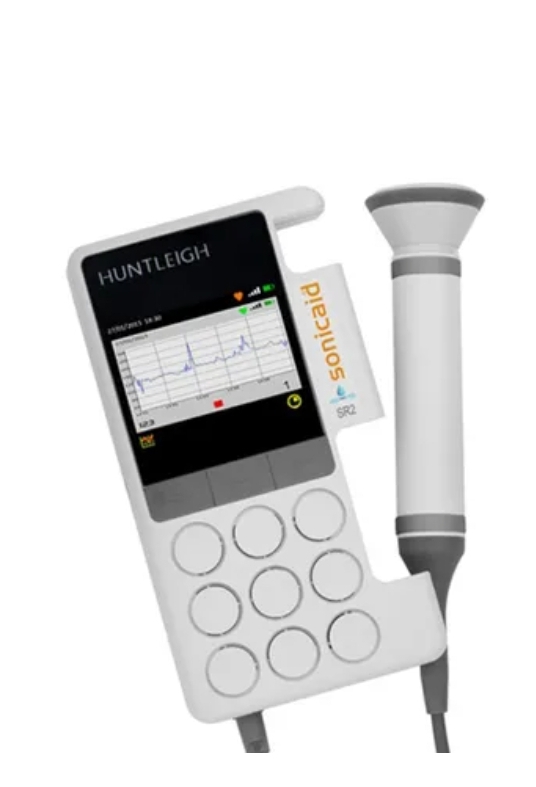
6) Sonicaid Digital SR2/SR3, Digital Doppler with Fetal Heart Rate and Tracings Display
- The Big Numbers & Trace Displayed in High-Resolution Colour.
- With Multi-Functional Display.The Data Storage on Micro SD Cards
- The Integrated Charging & Connectivity.
- With the High Sensitivity Probes.
- The Dynamic Digital Noise Reduction.
Waterproof Rate & Trace Display Dopplers with fixed 2MHz or 3MHz
These high sensitivity handheld Digital Dopplers are intended for general purpose screening of the fetal heart at all stages of pregnancy from as early as 8-10 weeks, right through to labour. The attached probes are waterproof (IPX7) for high sensitivity FHR detection in both normal use and in waterbirth monitoring.
Choose between 2MHz (SR2) or 3MHz (SR3) fixed probe options. The 2MHz model is a general purpose probe for use at all stages of pregnancy. The 3MHz probe is the probe of choice for many clinicians for use in early gestation.
Demo video of Sonicaid Digital SR2/SR3, Digital Doppler with Fetal Heart Rate and Tracings Display
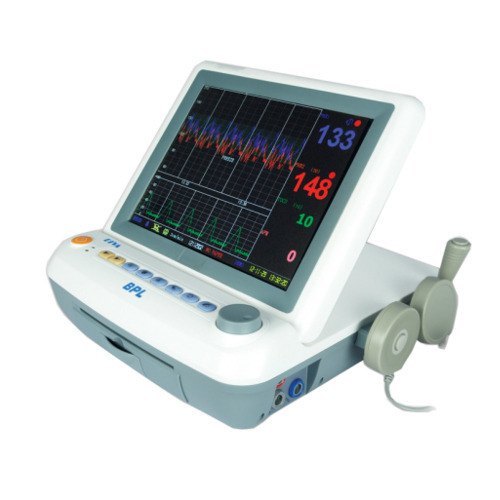
7) BPL fetal monitor, BPL FM 9853 Fetal Monitor
- High resolution color LCD with foldable screen
- Monitoring of FHR/Twin FHR (FM 9854), TOCO, Fetal Movement
- High-sensitivity water-proof ultrasound probe
- Automatic Fetal Movement detection with Event Marker
- The device is compact, portable and lightweight
- Data storage facility, Li-ion Battery, 152mm Thermal printer
FM 9853 has a larger display which helps monitoring from longer distance. Has high sensitive water-proof FHR probe, Manual and Automatic fetal movement recording function.
Demo video of BPL fetal monitor, BPL FM 9853 Fetal Monitor
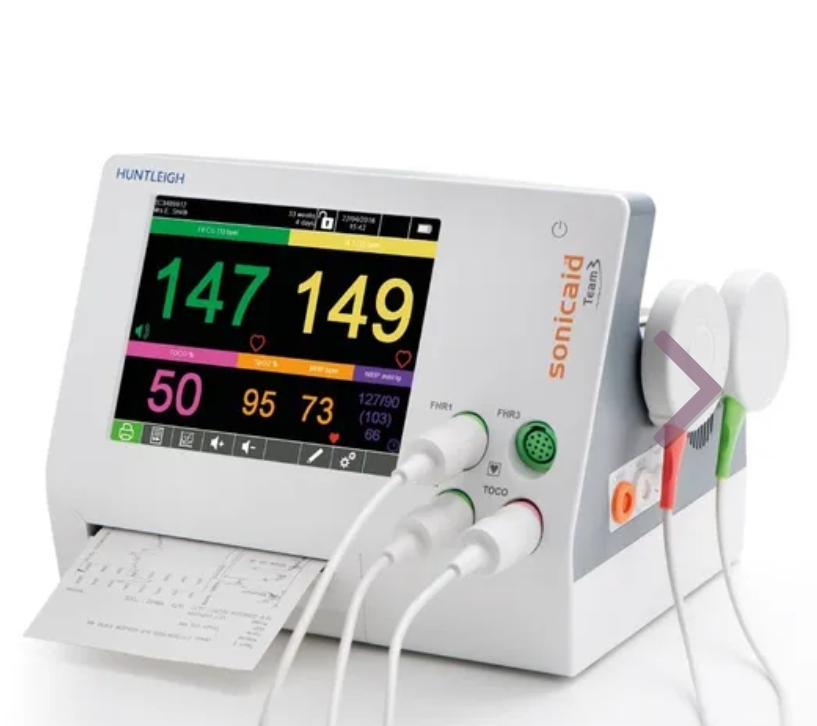
8) Sonicaid Team3 Series, Fetal/Maternal Monitor
- Dual Fetal Movement Markers (Manual & Automatic).
- The High Performance Audio for the most Sensitive Fetal Heart Detection.
- The latest Most Powerful Release of the World-Renowned Dawes-Redman CTG Analysis.
- Mains / Battery operation.
- Integral Patient Database with Trace Memory with Unlimited Storage Capacity.
- User Configurable Fetal & Maternal Alarm System.
The Sonicaid Team3 Series is easy to use and intuitive via the icon-driven touchscreen, and the fetal heart rate can be displayed as “Big Numbers” and auto-scales depending on single, twins or triplets monitoring for optimum visibility. The NEW Team3 Series is full of features to provide cost-effective, reliable and accurate fetal/maternal monitoring: Automated Sonicaid Actogram and maternally sensed fetal movements are also available.
Demo video of Sonicaid Team3 Series, Fetal/Maternal Monitor
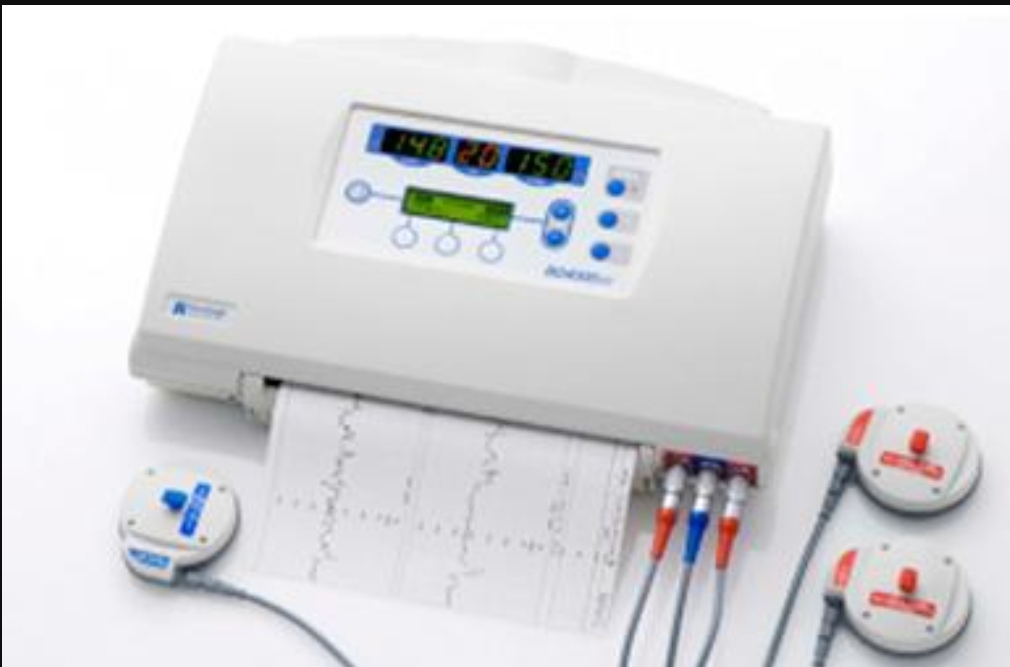
9) BD4000AXS-2 Antepartam Fetal Monitor by Arjo Huntleigh
- 2-year warranty for parts exclusive of cables and crystals 1 year
- 1.5 Mhz Ultrasound transducer
- External Contractions transducer (TOCO)
- Automatic fetal movement detection
- LED and audio FHR indicator
- Clinical event marker and annotation feature
- Fetal motion detection alarms
- Communication ports
- 2 x RS232 Serial Ports
- Interface to Central Monitor
- The Digital Numeric LED Display
- Adjustable-rate range alarms
- High-resolution thermal printer
The new BD4000xs series of fetal monitors are the latest in the range of obstetric products that have established Arjo Huntleigh as a leader in its field.
The BD4000xs series of fetal monitors provide solutions for all areas of fetal monitoring. Our fetal monitors for sale are cost-effective, compact and easy to use. All come configured with dual displays and ports for a simple, cost-effective upgrade pathway to twins monitoring. All come standard with communications ports for connection to Obstetric Archive, a unique software viewing and archiving tool, designed for the office market. Order this Huntleigh fetal monitor today.
Demo video of BD4000AXS-2 Antepartam Fetal Monitor by Arjo Huntleigh
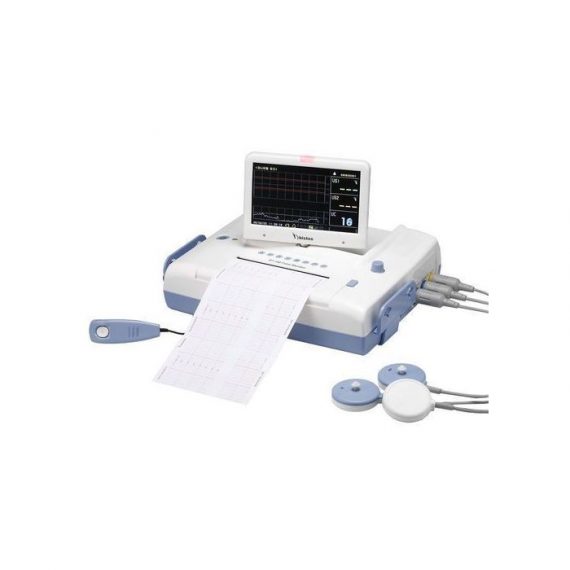
10) Bistos BT350 Fetal Monitor
- BT-350 LCD – displays traces and numbers. Stored data can be reviewed afterwards.
- CTG Analysis* – calculates important data such as baseline, Acceleration, Deceleration, fetal movement.
- Cross Channel Verification – prevent the FHR is miscalculated by twin fetuses by an alarm.
- Portability – Compact design with built-in handle enable portable use especially to midwives.
- Rechargeable Battery* – Li-ion battery enable BT-300 can operate without AC power for up to 3 hours.
- Acoustic Stimulator* – Stimulate sleeping fetus to speed up the test or to
- facilitate further evaluation of the non-stress test (NST).
- Zoom-in Function – Enlarge FHR graph scale on the paper to examine the trend with more dynamics by focusing FHR range to the most frequent area
- Connection – Maximum connection: 16 monitors, Wire connection: RS-232C, LAN*Wireless connection: Bluetooth (optional)
The BT-350 LCD is an Antepartum Fetal monitor displaying FHR, UC and FM on the LCD screen to check fetal health. It has the same functions as the LCD type except having a large 7-segment LED showing all the setting parameters and not having trend mode. It has also an event marker enabling a pregnant woman in the red to indicate fetal movement point by pushing the button herself when she feels fetal movement.
Demo video of Bistos BT350 Fetal Monitor
Things to consider before buying fetal doppler
Fetal monitoring and dopplers is a vital tool to measure fetal health. Monitoring is a key to reducing intrapartum stillbirths. Fetal monitoring can occur in a variety of ways, but stillbirths most devices are still prohibitively expensive for low-resource settings.
Without any technician guidance, you are not able to use this device and it can be harmful to your baby during pregnancy.
Before, purchase any doppler device you first ask and take advice from your doctor. Your doctor will give an utter recommendation and tell you about the usage in the right way. Apart from that, before purchasing any fetal device you just need to check out the functions, quality, screen, sound quality of the device. And also should check the reviews as well.
Price list of fetal dopplers/monitors
| S.No | Product/Model | price |
| 1) | Philips fetal monitor, Philips Avalon FM30 Fetal Monitor | INR 2,80,000 |
| 2) | Philips Avalon FM20 Fetal Monitoring CTG Machine | INR 2,80,000 |
| 3) | BPL Fetal Monitor FM9852, Fetal Heart rate monitoring for Hospitals Baby Monitor | INR 95,000 |
| 4) | CONTEC Cardiotocography Machine, CMS800G Fetal Monitor baby Heart FHR TOCO Fetal monitoring | INR 59,000 |
| 5) | fetal monitoring Contec Fetal Monitor CMS800G1 | INR 40,000 |
| 6) | Sonicaid Digital SR2/SR3, Digital Doppler with Fetal Heart Rate and Tracings Display | INR 36,000 |
| 7) | BPL fetal monitor, BPL FM 9853 Fetal Monitor | INR 1,00,000 |
| 8) | Sonicaid Team3 Series, Fetal/Maternal Monitor | —- |
| 9) | BD4000AXS-2 Antepartam Fetal Monitor by Arjo Huntleigh | INR 3,00,000 |
| 10) | Bistos BT350 Fetal Monitor | INR 60,000 |
Final thoughts
Fetal doppler/ Fetal monitoring is the safest way to check your baby’s heart rate condition and other functions. This device checks your baby’s condition inside as well as outside the abdomen and if any problem may happen, tracks the condition during the pregnancy but this device you can not use by yourself. You need to use it under doctor consultation.
Frequently Asked Questions:
- Can I get out of the bed with a fetal monitor?
yes, you can get out of bed with a fetal monitor or can sit on a chair or also, stand near the monitor. But you can’t walk around and take a bath. Sometimes you can check the baby’s heartbeat without wires.
2. What is the most accurate procedure for monitoring normal pregnancy?
Auscultation is commonly considered or an acceptable form of monitoring if your pregnancy is at low risk.
3. Who needs continuously fetal monitoring?
Most experts recommended continuous EFM for those people in labor who have the prior Cesarean. This is due to the most common sign of uterine rupture being fetal heart rate abnormalities. Abnormal heart rate patterns occur with 70% of uterine ruptures.
4. When can I stop fetal monitoring?
Fetal is before Cesarean birth, women requiring Cesarean birth fetal surveillance should continue unless abdominal sterile preparation has begun; if internal fetal monitoring is in use; it should continue until the abdominal sterile preparation is done.
5. Is external monitoring safe?
There is no physical risk, fetal monitoring risk with the auscultation or external fetal monitoring. On the other hand, an internal fetal monitor carries a little risk of infection. it invades the uterus.
6. What is mobile fetal monitoring?
during, labor your doctor and nurse will check your baby’s heart rate to track the whole procedure how is the baby doing and tolerating the contractions. The electric monitor is used to detect the signs of the fetal distress.
7. Baby monitoring during C-section?
Fetal monitoring is important during the C-section while the mother has been giving the general anaesthesia reason, the anaesthesia can negatively impact the fetus the risk is higher infants who have exhibited signs of fetal distress before the surgery.
8. How? Accurate the fetal monitoring
Results: The positive percentage agreement was 81.7 and 73% of the abdominal fetal ECG and ultrasound. The abdominal fetal ECG has a lower root mean square error (5.2 vs. 10.6 bpm, p < 0.001) ultrasound.
9. How does wireless monitor works?
Here is an electronic device called a transducer attached to the wide, stretch bands that will be placed around the belly. This device can monitor your baby’s heartbeat. Another device can track your contractions that are usually attached to the second band around your belly.
10. When you have to start CTG monitoring?
The continuous CTG monitoring should be started in the first stage of labor and during the expulsion stage, however high risk in pregnancy.

